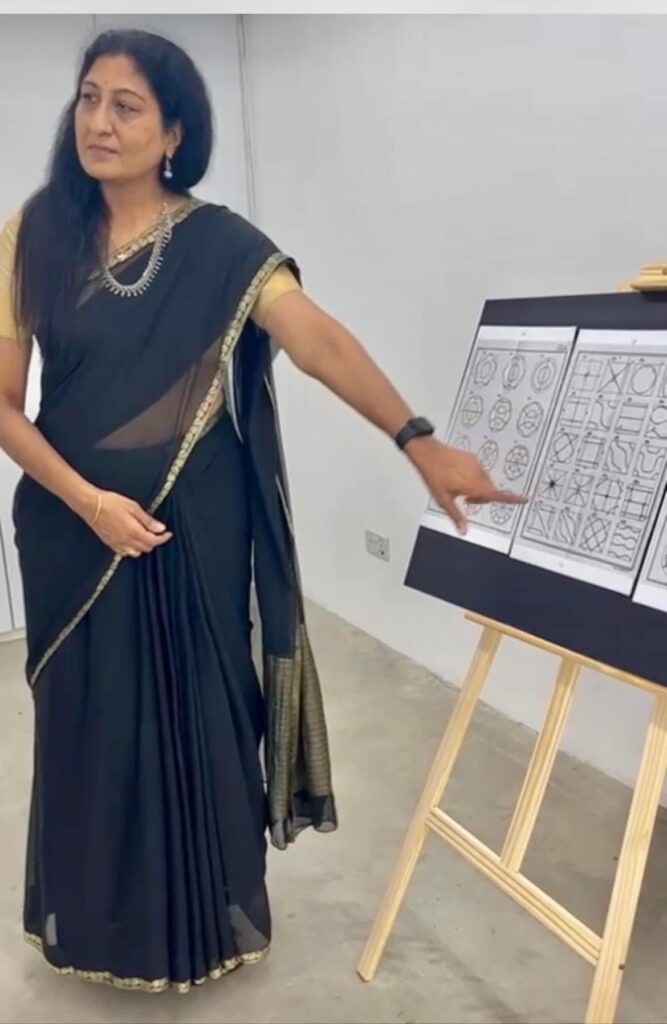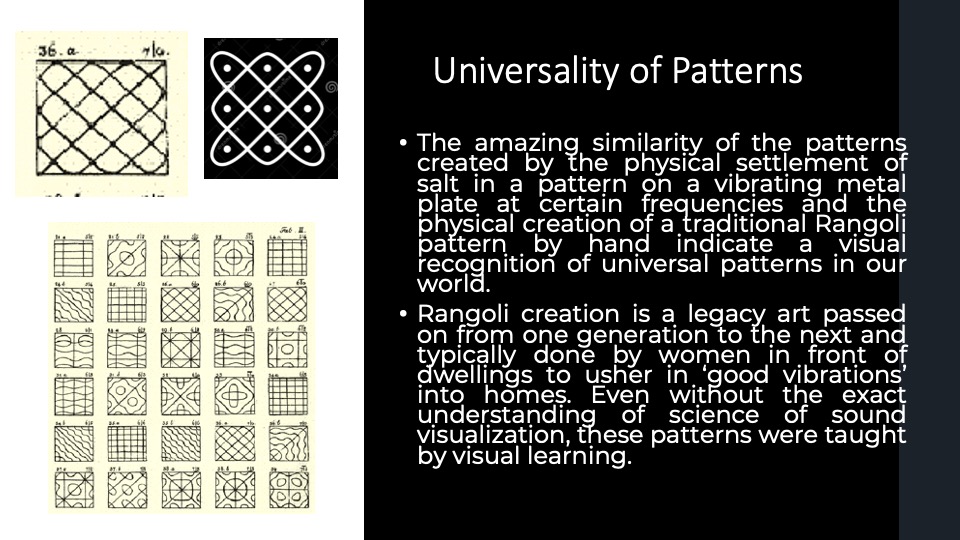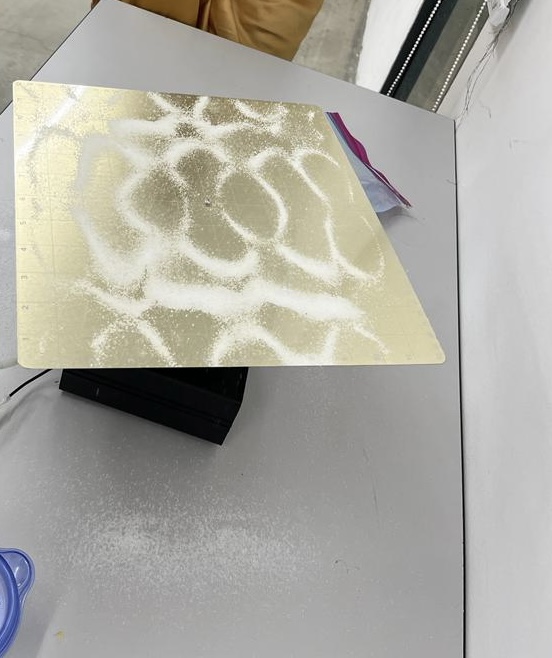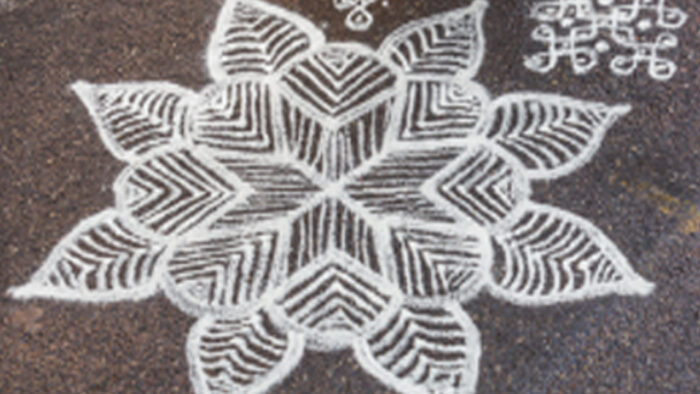Kumuda Krovvidi is the Founder Director of Strokearts Studio Pte Ltd, Singapore, a visual arts company engaged in enriching lives through art education. Her latest project focuses on the universality of patterns, both visual and through sound. For instance, the patterns created by the settlement of salt on a vibrating metal plate at a certain frequency and the physical creation of a traditional rangoli with hand point to a universal aesthetic of symmetry and design.
Kumuda has over ten years of experience in teaching art in Singapore. She holds a Certificate in Western Art (Part Time) from Nanyang Academy of Fine Arts (NAFA). Her vision is to create an enrichment environment of skill- based training for visual arts such as drawing, painting and sculpting in Singapore. She has a passion for painting and is an artist who encourages awareness and appreciation for visual arts – especially Indian Art such as Madhubani, Warli, Kalamkari, Pata Chitra and Gond. She has co-authored a book titled ‘Introduction to Indian Folk- Art Painting’ in Singapore.
Kumuda recently held an exhibition titled Rangoli Resonance Art: Visualisation of Sound Vibrations as Rangoli Designs, at Singapore. She says that vibrations of sound can be captured as images with the help of tools. In this interview she talks about her interest in art and culture.

What was different about your process in using sound as an artistic tool?
In my art exhibition titled Rangoli Resonance Art, I have used sound frequencies to bring attention to universal patterns that corelate to those sound frequencies. These patterns are found in all of our surroundings, in snowflakes, in nautical shells, in animal life and the plants and in our Universe.
What makes my study different and unique is the corelation of sound frequency patterns with Rangoli/Kolam , a traditional legacy art of designs and patterns created by women in front of homes to usher in auspiciousness. Rangoli patterns are usually created from a graph of dots that enable the geometry to remain intact and are amazingly like the meticulous records of patterns studied by physicists.
Chladni plates make it possible to visualise sound frequencies as patterns. Physicist Ernest Chladni discovered different patterns being formed by sand particles placed on a metal plate when the plate was vibrated with sound at different frequencies. The study of visible sound is called Cymatics and it reveals fascinating truths about our universe that go unseen by the naked eye. Sounds actually have a distinct geometry, much like crystals and flowers and nautilus shells. When picked up by a special apparatus such as the sand-covered plate called a tonoscope, these vibrations reveal incredible geometric shapes that are unique and representative of universal phenomenon.

How have your studies in Western art influenced your perception of Asian art and vice versa?
I completed a Certificate Course in Western Art from Nanyang Academy of Fine Arts (NAFA), Singapore and it helped me understand a few basic principles of composition and technical skills in creating art. Still Life, Figurative painting, Landscapes and Abstraction were explored as subject matter and themes for composition.
It also helped me understand that the approach to creating Asian Art is perhaps more holistic and offers a utilitarian purpose to the creation. The process of creation must benefit the creator as well as the viewer and serve the objective for its creation.
Western art commonly utilizes the principle of creating an illusion of three-dimensionality of space whereas Asian art has linear drawings that tend to have colour filled in to give form. Western art is more about the treatment of the subject of the artwork whereas Asian art is more about the context in which the artwork is created. Asian art is usually a piece that has many elements to it and the sum of all parts is to be appreciated in its entirety.

What drew you towards art as both a career and passion? Have you always been an artist?
I am a Chartered Accountant by professional education but decided to devote dedicated time for art since many years, so that I can follow my passion for art, especially Indian Art. My mother was an artist and applied artistic creativity in almost everything she did in her daily life. This has inspired me and moulded my personality to be curious about artistic processes involved in all activities of our daily life. She has imbibed in me a love of lifelong learning. As I realised that my passion for art gave me fulfilment as well as an option for a career in art, I have founded Kriti Arts Limited in 2023, a Public Company incorporated to use art for public good. I am co-founder of Strokearts Studio Pte Ltd, a Company engaged in providing art education in Singapore.

Could you elaborate on your findings about the similarities between cave art in India, South-east Asia and China? What inspired you to study these art forms deeper and bring them to the public?
There is a strong similarity in the Fifth Century Classical paintings in Ajanta Caves, India and Dunhuang Caves in China, as well as Sigiriya Paintings in Sri Lanka. These Buddhist paintings extol the virtues of Buddha and explain the life stories associated with enlightenment of Buddha. It follows from the Silk Route across Southeast Asia where trade and spiritual ideas were exchanged in the various cities and towns dotting the route. The Buddhist monks used the Silk Route to visit many cities and spread the wisdom of Buddha through story-telling. They also created paintings as a visual aid or prop to support their story telling sessions. During the monsoon, they took shelter in caves until the season passed. The cave paintings were created as a practice of meditating and depicting the stories from the life of Buddha.
The technique of creating the cave paintings, that is painting over rock is similar in all the three locations mentioned. Surprisingly, the rock caves have similar sculpting in terms of architectural designs especially the decorative walls and ceiling carvings.
The study of these cave paintings is necessary if we need to learn about what can be referred to as the classical art of India in terms of paintings. The Western art has the concept of classicism that was derived from Graeco-Roman antiquity.
The Ajanta Cave paintings created in the Buddhist era are the earliest form of classical paintings in India that were sophisticated in technique, three-dimensional in presentation and very large in size. The process by which paint was made to adhere to the carved rock surfaces was advanced in terms of the scientific knowledge of chemical reactions of different materials such as pigment, brushes, and natural glue. They had such archival quality that they survived across centuries and can be viewed even today in its original form in many sections.
These paintings have fascinated artists, including me, to study and re-create these paintings using new materials.

How do you bring your unique perspective to both your art and to your teaching? Is it easy to communicate and document your process for students?
As a practitioner, discovering an artistic process is very satisfying and applying it to create an artwork gives immense satisfaction. Teaching students involves breaking down the process into lessons that can become a part of a curriculum. This involves documenting it in terms of written notes, live demonstrations, and video recordings.
I have come to realise that not all artists can teach and not all teachers want to become practitioners. To be able to do both requires a certain skill in presenting a complex idea into simple skills. And therefore, skill-based learning is a very good way to embark on the artistic journey.
Similar to sound as art, have you explored any other senses that are usually overlooked in art? What would you like to experiment in?
I do believe that light has always been the key to creating the illusion of the three-dimensional quality to art. Joining two dots gives a line, joining lines gives a shape, but it is the use of light and dark that gives the shape a three-dimensional form on a flat surface such as paper or canvas. This quality of light is something that piques my interest and is going to be a theme I would like to explore.
What do you find are the intersections between music and art therapy, after your work in art and sound? Is there a way to integrate the two?
There is an undeniable co-relation between music and wellness. The methods of creating art with music promotes inner perception, opens paths of access, and enables forms of expression to interact with oneself and one's environment without having to speak.
In my book published in 2021 and the accompanying art exhibition, titled Visual Melodies- Illustrated Music in Indian Miniature Painting, I had the opportunity to study Ragamala Paintings, a genre of Indian classical art. The paintings are a pictorial visualisation of musical melodies called ‘Ragas’ in the form of personified iconography. The paintings depicted characters, such as deities, having expressions of emotions that the characters experience upon the happening of a condition, for example sadness upon the condition of parting of lovers, joy on seeing the arrival of a beloved etc. The study revealed the fascinating truth about how the purpose of creating the paintings seemed to be to offer a wholesome approach to a natural aspect of human nature, which is to understand and appreciate the world in a condition-emotion context. Being human is to be able to experience many emotions in a lifetime and to find one’s place in the interconnectedness of things in the world. Especially in terms of human interactions and interaction with nature, birds, animals and even planets.
The integration of art and music has been in existence, and using this integration as an approach to study self-expression is one of the foundations of art therapy.





